In the mornings, Panchito Olachea likes to walk. He sets off at six with his dogs trailing behind, a pack of neighborhood strays he has taken in over the years. It is quiet on the edge of sprawling Nogales, Sonora, a busy industrial port in northern Mexico. From the crest of the hill where Panchito lives, the city’s hectic, backed-up traffic lies behind the rise, out of sight. Before him, the desert unrolls serenely to the horizon, low and gold, interrupted only by the border wall: a rust-red ribbon dividing the view neatly in half.
Nogales is a single city divided in two by the United States–Mexico border. Of the paired cities along la frontera—El Paso and Ciudad Juarez, San Diego and Tijuana, Brownsville and Matamoros—Nogales is unusual in that both sides share the same name. Together, they’re often referred to simply as Ambos Nogales. Until the middle of the last century, the two halves of the town held a joint Cinco de Mayo parade that wove back and forth across the street that officially separates Mexico from the U.S., called International Boulevard.
Like many border cities, Nogales is a place where people come to press close to the other side. Some move to Nogales, Arizona, to stay near family members stuck in Mexico. Others end up in Nogales, Sonora, looking to cross, whether through the backed-up asylum system or with the help of a coyote. For some, the border is a point of transition, and for everyone else, without a way through, it is the end of a road.
Every morning, before work, Panchito walks away from Rosarito II, the squatters’ neighborhood where he lives, and toward the U.S. He follows the ridge as it drops, relishing the quiet hour to himself before he will get into his ambulance to make his daily rounds of Nogales’ migrant shelters.
And every morning, when he reaches the grove that stands at the foot of the hill, a hundred yards from the rippling steel fence that marks the edge of Mexico, Panchito turns back. He has crossed the border before. The first time he was 16 and the last time, coming the other direction, he was 48. He doesn’t expect he will cross it again.

Founded as a railroad outpost in the 1880s, Nogales spent most of its existence straddling a line that was more a formality than a hard fact. There was a chain-link fence for much of the 20th century, but kids (and others) wriggled under it when they didn’t want to wait in the checkpoint line. During Prohibition, at least one binational bar let American patrons drink so long as they stood on the Mexican side of the room. Today, International Boulevard is staked down its middle by a row of 18-foot-tall steel bollards sheathed in gleaming coils of razor wire.
Though the two halves of the city started out roughly the same size, a North American Free Trade Agreement-fueled rise in manufacturing jobs in the second half of the 20th century contributed to a huge boom on the Mexican side of the wall. The population grew from 50,000 in 1960 to well over 220,000 today. (Unofficial estimates come closer to 350,000.) With affordable housing in short supply, the very poorest often end up on the edges of the city, where squatter settlements called invasións take root and grow.
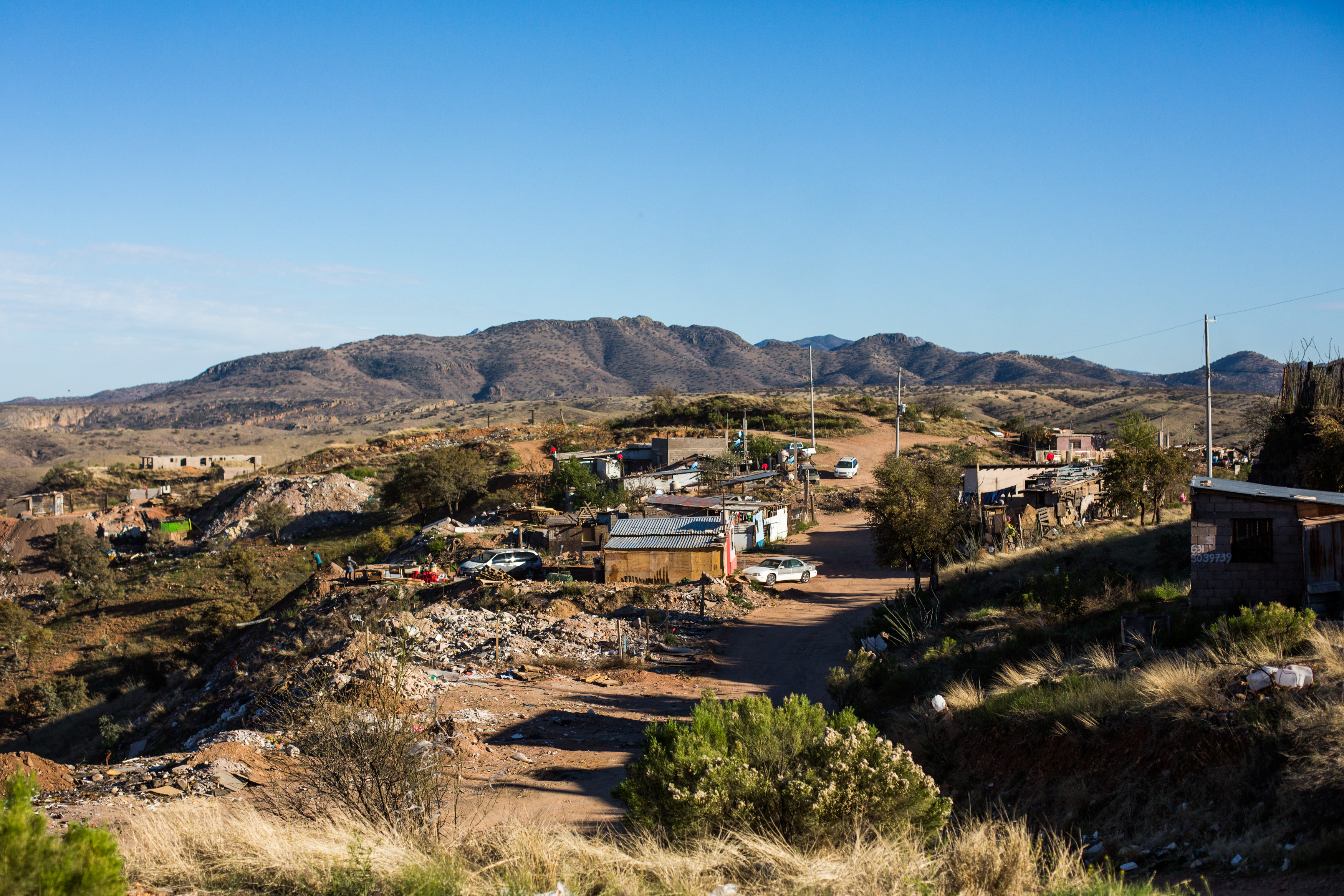
(Photo: Celia Talbot Tobin)
Rosarito II, where Panchito lives, is one such neighborhood. It was an active dump until 2012, but people have been living there since at least the early 2000s. Along the steep dirt road that winds up to the hilltop, families still pick through the piles of trash, looking for material to use or resell. Small one-room houses hug the side of the hill, which has been regraded to make more room and, in the steepest places, terraced with old tires. The better houses are made of cinderblock; some of them even have doors.
But in this neighborhood patched together from bits of trash, an unlikely community has grown. Community and religious groups work to provide food and housing for the families who live here. There’s a home for children, and a rehab center for drug addicts, where many like Panchito have found a refuge after being deported from the U.S. Looking over the border every day, they work to build a home in a country they never chose for themselves.

To cross from the U.S. into Mexico is so easy as to be anticlimactic. I walk from the Burger King parking lot, which sits on a slight rise one block north of the border fence, toward the low concrete Customs building, then follow the signs around the side to an oversized x-ray machine, where a bored-looking guard watches the contents scroll past. There are no lines. No one looks at my passport or asks what brings me to Mexico. I just walk out the other side, where I am greeted by signs advertising the exchange rate and hopeful calls of “Taxi! Taxi!”
Things are immediately livelier on this side of the wall. Vendors crowd close to the crossing with baskets and carts, and shop owners wait outside their souvenir stores to wave in passersby. The busy tangle of roads are ruled more by principles of fluid mechanics than traffic law.
Panchito emerges from a row of municipal offices beside the border crossing. In his navy polo and work boots, he moves with a light step that belies his 59 years. He is short and sturdy looking, with a bald head and arms tanned a deep walnut. His serious expression, accented by heavy eyebrows and a steely beard, frequently gives way to a wide, toothy smile.
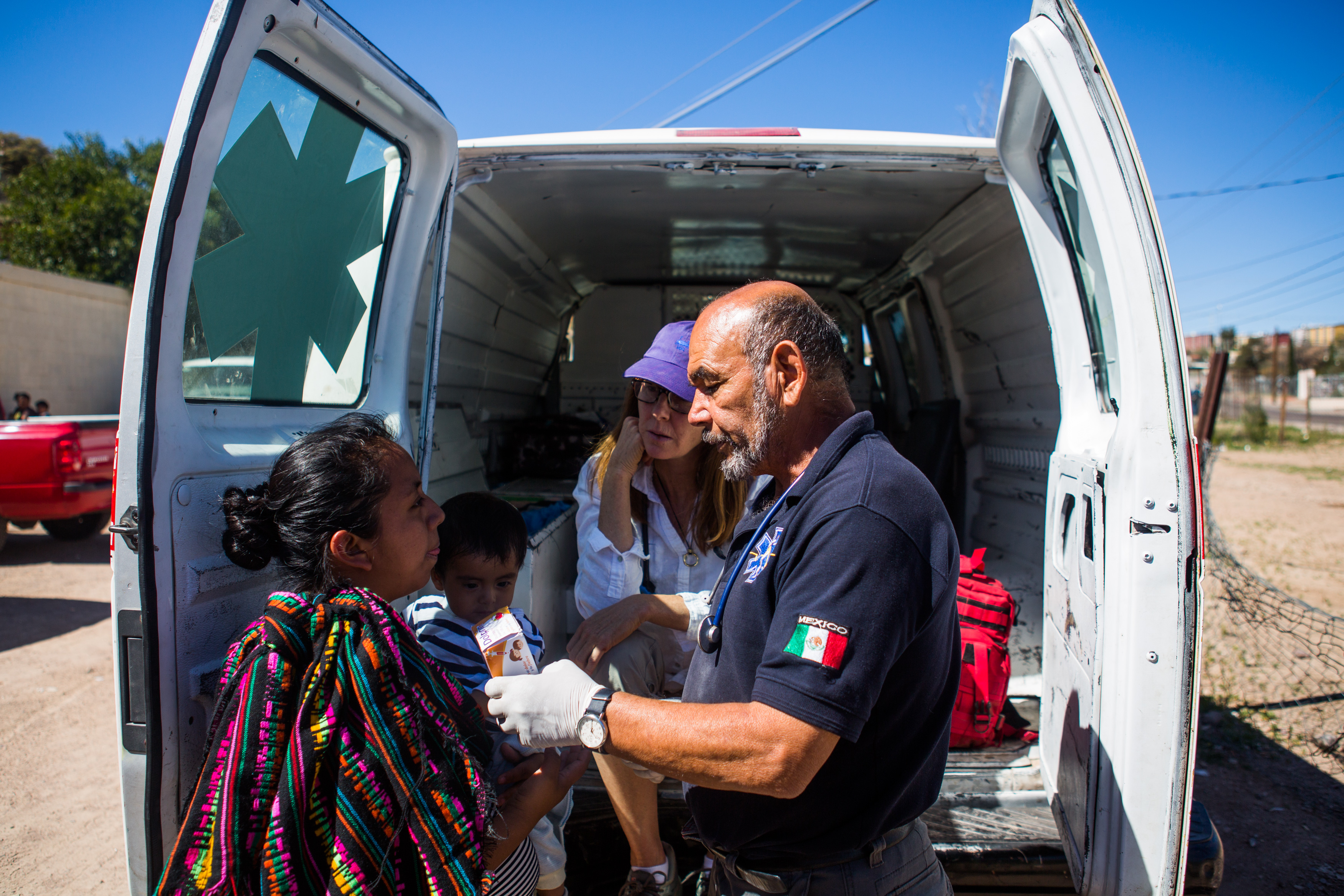
(Photo: Celia Talbot Tobin)
Trailing after Panchito are about 15 women and children. These are the newest arrivals to the border, most having traveled from Central America or southern Mexico. They will spend the next days or weeks waiting for their asylum cases to be heard. In the meantime, Panchito will take them to a shelter where they can get food and a place to sleep until their numbers are called up. The asylum seekers, in their carefully enumerated limbo, share the crowded shelters with the recently deported, whose particular purgatory is less ordered, with no clear next step.
He leads the group to a parked ambulance, with block letters on the side spelling out “Panchito y Su Christina.” His name is really Francisco, but no one calls him that, and Christina is one of his daughters, though most assume it’s the name of the ambulance. For the last 10 years, he has run a kind of freelance medical service in Nogales, starting with just a backpack full of Tylenol and cough medicine. Six years ago, he got his first ambulance and today he’s a familiar sight in Nogales, driving between the city’s shelters to dispense advice and medicine to a population frequently overlooked by Mexico’s overburdened health-care system.
This is Panchito’s second life. When he was a teenager in the 1970s, he left his home in Baja California, Mexico, to find work in the U.S. It was easier to cross the border back then, and he slipped into San Diego without much trouble. He ended up in Phoenix, where he became a welder and sometimes worked three or four jobs at a time. He got married and raised three daughters, who he took pride in supporting. “I had a little car. I had a medium car. I had my work truck. I had a four-bedroom house,” he says. “I was competitive, OK?”
In 2008, police arrested Olachea on charges of driving under the influence. He had spent 34 years in the U.S. and expected to live out the rest of his life there. Instead, in short order, he was deported.
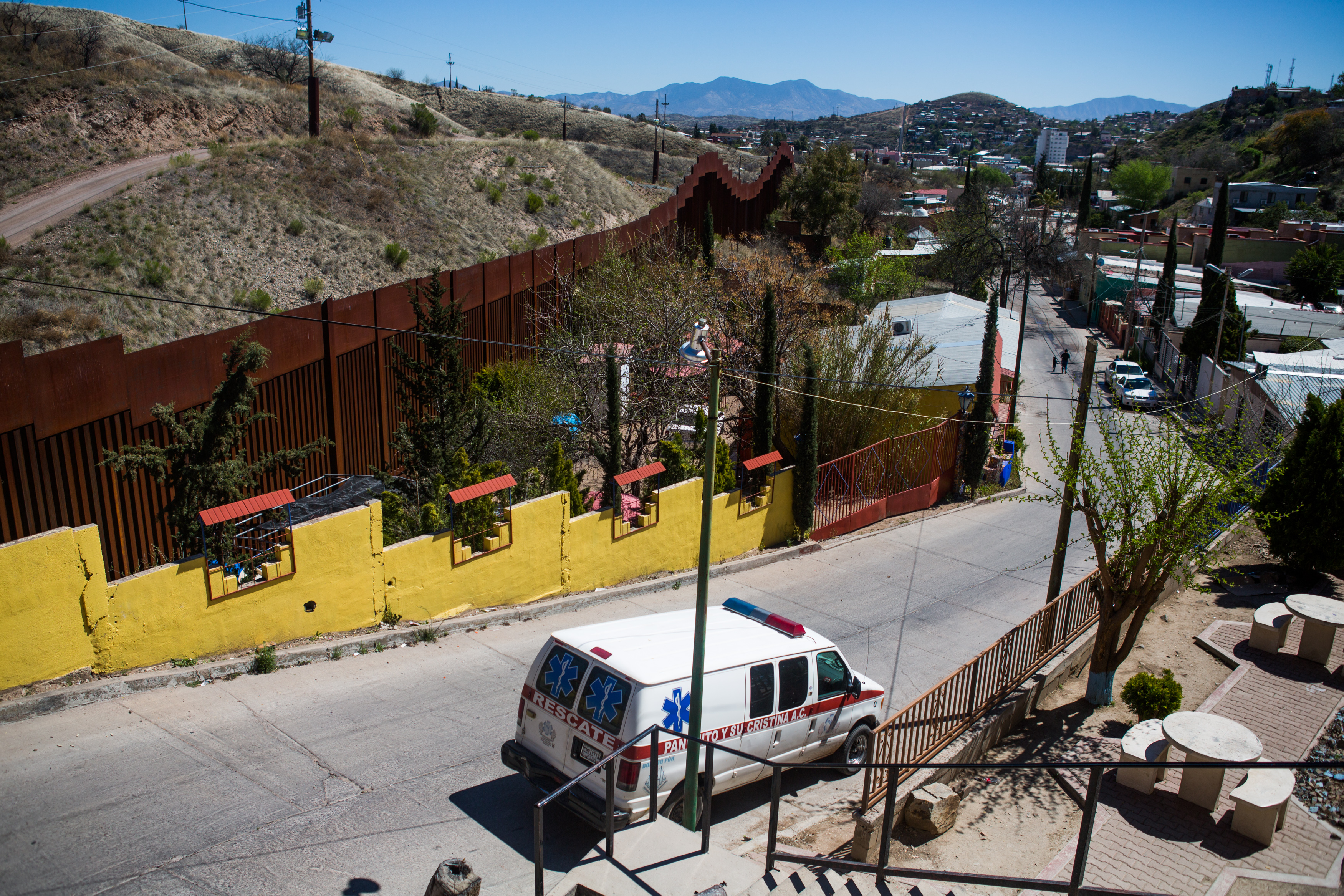
(Photo: Celia Talbot Tobin)
“I call it that I died,” he reflects, 11 years later. He still doesn’t like to talk about it. “When they send you to this country, you don’t have anything. You lost it all.”
Homeless and jobless, separated from his family, Panchito ended up sleeping in the city graveyard for a while, after he had used up his allotted time in the shelters.
“One day, I just woke up bleeding from my nose,” Panchito remembers. It was hot in the cemetery, and he was so hungover he couldn’t get up. “I just said, man, was this what you wanted to be when you grew up?”
He knew he had to do something different. “I couldn’t keep crying. I couldn’t keep drinking,” he says. He started volunteering at the migrant shelters he’d once stayed in. An American volunteer helped him rent an apartment in Nogales while he studied for his GED, then enrolled in the local university. He got his nursing license and started walking around town, helping anyone who asked him. “The migrants became my family,” Panchito says. Exiled from his former life, he was starting to understand the shape of his new one.
“I died,” he says again. “I told my daughters, you can come and see me, see? My grave is open. All you gotta do is be able to stand in line when you go back.”

America’s deportation policy has grown in fits and starts, along with the country’s relentless expansion. The first law that gave the government permission to remove immigrants from American territory was passed in Massachusetts in 1794, then largely aimed at poor Irish laborers. The Immigration Act of 1882 and its later expansions established categories of “undesirable” immigrants who could be deported, including “idiots, insane persons, paupers or persons likely to become a public charge, persons suffering from a loathsome or a dangerous contagious disease, persons who have been convicted of a felony or other infamous crime or misdemeanor involving moral turpitude, [and] polygamists.”
These laws increasingly targeted Mexican immigrants in the 20th century. During the decade and a half after the Great Depression, America deported or coerced more than two million Mexicans and Mexican Americans into leaving the country, including many who had U.S. citizenship, in response to populist claims that they were taking jobs from white Americans. The Bracero labor program of the 1950s came with another wave of deportations, under the name Operation Wetback.
In 1996, the Clinton administration signed into law the Illegal Immigration Reform and Immigrant Responsibility Act, which both made routes to legal immigration less accessible and stepped up the punishments for illegal immigration. In the past, immigrants who had entered the country illegally had a pathway to legal citizenship after 10 years. Now, if people like Panchito wanted to legalize their status, they would have to leave the country in order to petition for a shrinking number of green cards. Many opted to lay low instead. If they were caught and found to have spent more than a year in the U.S. without papers, they would have to wait 10 years before applying for re-entry.
Deportations have increased steadily since 2000, fueled by the formation of the Department of Homeland Security in 2002. By 2013, less than one fifth of all deportations were top-priority dangerous criminals. Under the Trump administration, the DHS has explicitly targeted all undocumented immigrants, not just those convicted of crimes or apprehended at the border. Immigration and Customs Enforcement staged raids on churches and courthouses.
Some of those people end up in Nogales.
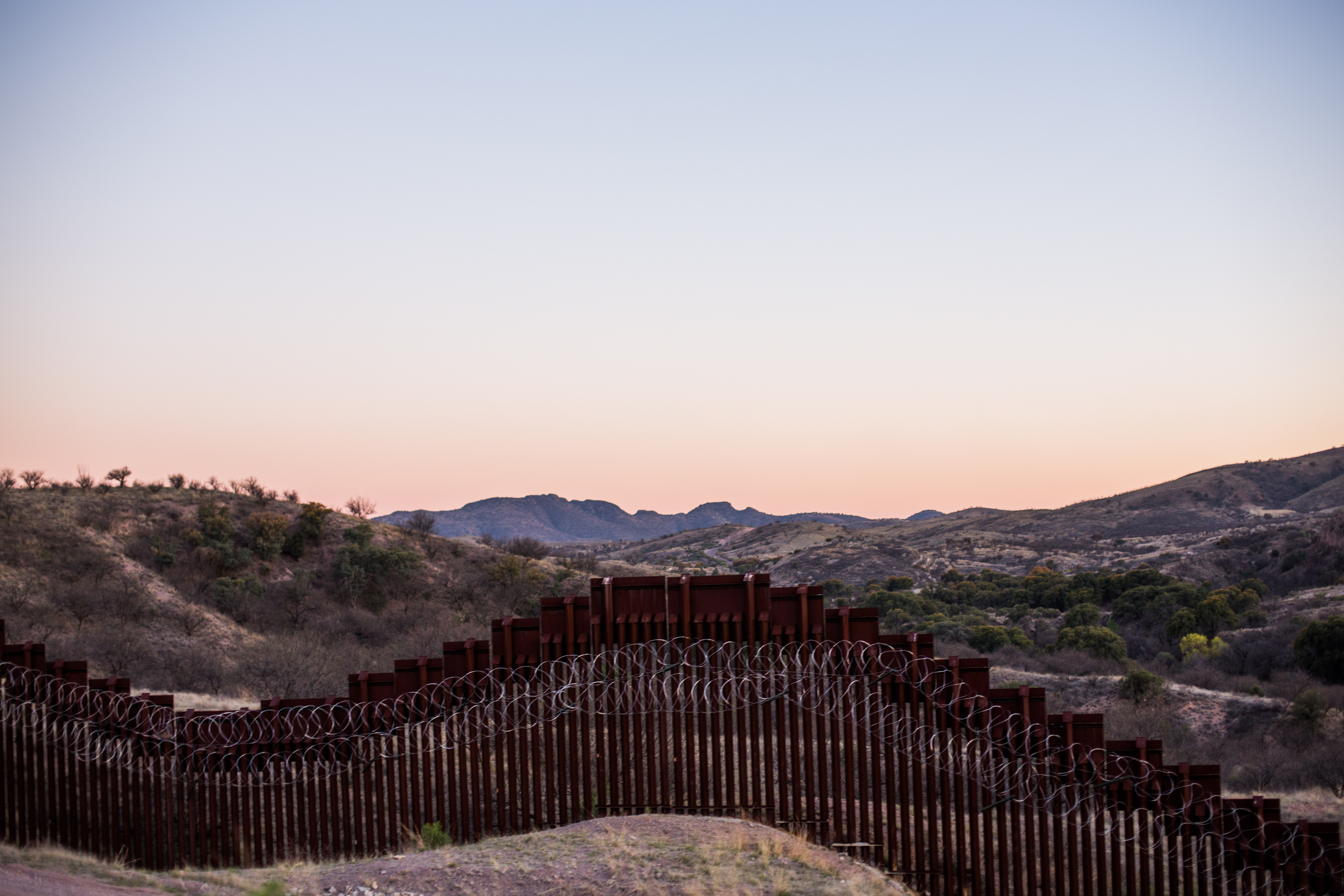
(Photo: Celia Talbot Tobin)
“I get many calls of people getting deported who want to be closer to their family in Tucson and Phoenix,” says Luis Torres, board president of FESAC, a community foundation in Nogales, Sonora. Some families might decide to relocate altogether, Torres says, even going so far as to put their American kids in Mexican public school in order to stay together. Other Mexican families may decide to send their kids to live with relatives or friends in Arizona to get an American education. Every morning, students on both sides of the wall wake up early to cross the border to attend school in a different country.
The densely layered realities in Nogales are common to the border, where movement in both directions has to negotiate physical and legal barriers. The fence that divides the two cities sometimes serves as a place of reunion, Torres points out. The steel bollards are tall and brutalist, but there is a narrow gap between the bars. Those few inches allow families whose members may not be able to cross the border to talk, share food, even touch.
Later, while waiting in the long line of people crossing back into the U.S., I watch two teenagers on opposite sides nestle their bodies into the narrow space between the metal posts, holding each other’s faces through the wall.

The Centro de Sueños rehab center is under construction. Men move purposefully around the flattened dirt courtyard where they’re building a new set of dorms for the center, carrying bags of cement and scraps of lumber. They greet Panchito in a mix of Spanish and English when he pulls up at the end of his daily rounds. Back in Rosarito II, we’re just down the hill from his own house, where he moved a few years ago so he could be close to the people who might need his medical help the most.
“You could call it a rehab center, but we’re disciples,” Luis Bonilla explains. He’s a graduate of the treatment program, and now serves as spokesperson for the Centro de Sueños, or Dream Center. Started by an evangelical preacher from Phoenix named Ramon Montoya, the Dream Center and the adjacent Iglesia del la Calle (“Church of the Streets”) make up the nucleus of a tiny neighborhood within Rosarito II. Spread across the hillside overlooking the valley behind the city of Nogales, the grounds include a house for the pastor and volunteers, a temple, a kitchen and dining hall, as well as several smaller outbuildings. The two-story dorm is the largest structure in the neighborhood, home to between 40 and 50 people at any time. When the new dorms are finished, that number will double.

(Photo: Celia Talbot Tobin)
Pastor Montoya first visited Rosarito II 12 years ago, when the dump was still active and the families living here worked among the bulldozers, picking through the trash. He started bringing volunteers from his church in Phoenix to serve meals to the kids. Meanwhile, while ministering in the federal prison in Phoenix, Montoya met young men who were serving time, often on drug charges, before being deported. They asked if he could help them when they were in Mexico.
“Most of the guys here were brought up, raised in the United States,” Montoya tells me over the phone. “They don’t even know where their family is. They don’t have anywhere to go.”
Montoya decided to give them a place. His first disciples built the church and the center, along with volunteers and donations from the congregation in Phoenix, and the place gradually grew by word of mouth. Being back in Mexico is a culture shock for a lot of the men, Montoya says. “Most of them want to go back to the United States. That’s why our facility, I try to make it as good as I can. I want to bring a little bit of, hey, it’s not that bad over here.”
“We’re the best kept secret in Nogales,” Bonilla says. He speaks English fluently, with a faint accent, like many of his fellow disciples. Like them, Bonilla lived in the U.S. for most of his life before he was deported in 1997. And like many of them, he ended up in Nogales, with no idea where else to go. He turned to drugs, he says, until eight years ago, when he came to the Dream Center and got clean. When it was over, he decided to stay on as a volunteer. “So now I’m helping and I’m here forever, I guess,” he says. His tone is light, but he’s not joking.
In a small room off the main courtyard in El Centro, a man named Enrique is turning out perfect circles of batter onto a griddle and then tossing the finished tortillas onto the rack that takes up most of the room, while another man slips the cooled discs into plastic sleeves to sell in town. Next door is the dining hall, assembled out of flat plywood panels from spools of electrical wire, where the men share their meals every day. The walls are marked with crescent-shaped grooves where the cable once wound. A reproduction of the Last Supper hangs above the long table that runs down the center of the room.
“Now we’re going to do a little climbing,” Bonilla says. I follow him past the pastor’s house and up a set of concrete stairs in the hillside. The concrete is new and neatly squared off, leading to a broad patio of peach-colored stone.
“See all this rock work?” Bonilla points out. “The men did it. These men, society once said that they didn’t work anymore, they didn’t want them. But then they come here and look what they can do. They’re very valuable.”
There is room for a garden, and a bench overlooking the valley behind Nogales. From up here, we can see the rough edges where the Center is still growing outward, framed in plywood and corrugated tin. Montoya has purchased nine acres of land here and wants to add more. In the distance, the wall slinks across the hills. On the other side, the small white dot of a Border Patrol truck rolls slowly along.
I ask Bonilla if it is strange to be up here looking into the U.S. every day. “At the beginning, yeah,” he says. “But you get used to it.”
He looks over the view.
“Since I’ve been deported for 20 years now, I can tell them, hey there’s hope. You can make a life here.”

Back in the ambulance, Panchito drives up the short hill to his house, a small unpainted cinderblock building with pots of climbing roses lining one side of a large patio. His dogs swarm him as he climbs out of the truck. Mama Dog, brindled and dark, is tailed by two fluffy, stumbling puppies. Monk, a suede-coated teen with a curious face, sniffs around the new arrivals. “He had no hair when we found him,” Panchito says, ruffling the dog’s ears. “You could count his bones from here to the corner. And now he’s all a success story.”
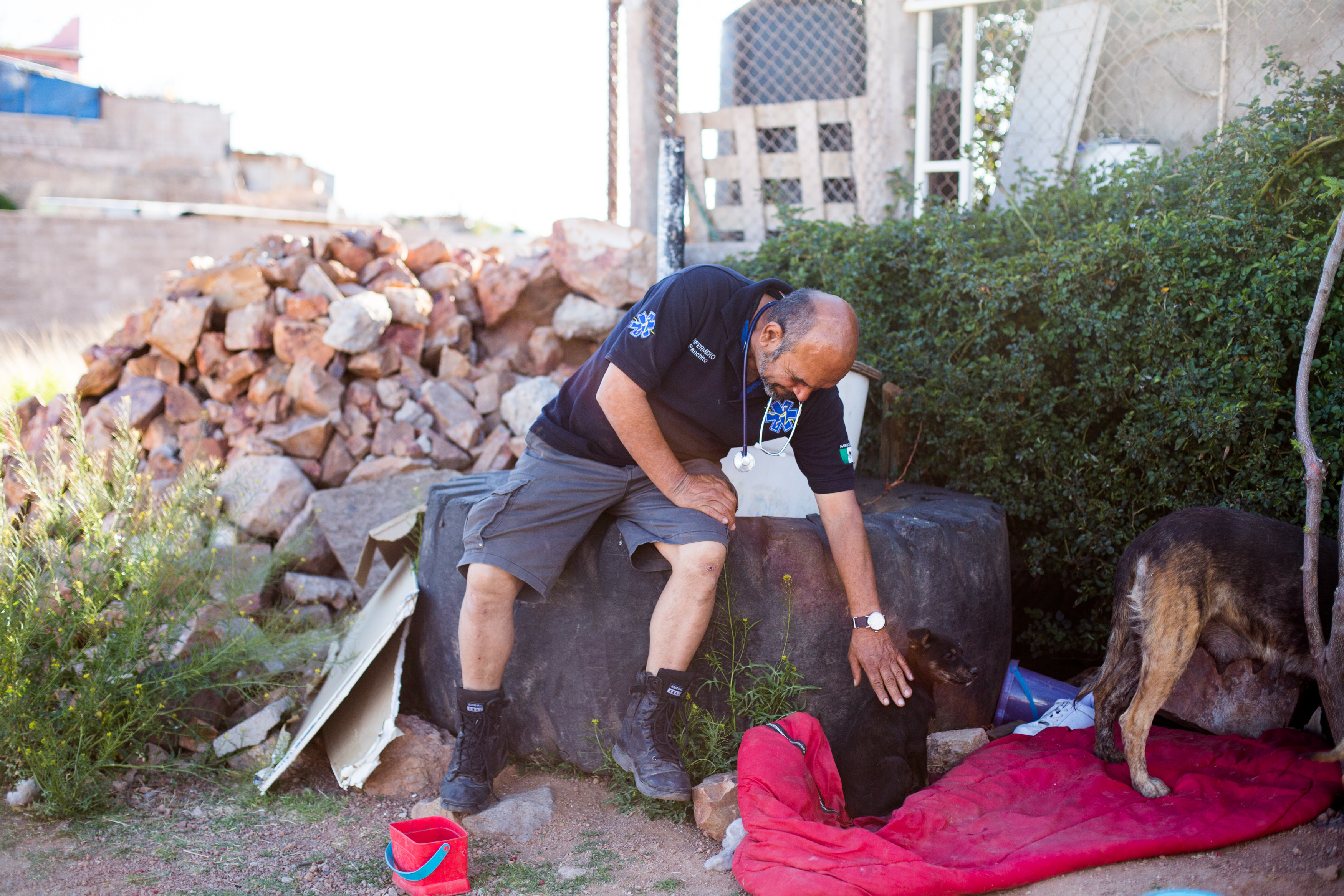
(Photo: Celia Talbot Tobin)
He scoops kibble into bowls while the pack push and tumble around him. “I never thought I was gonna come back to this country, to be honest,” he says. But when he started going to school again, he felt his sense of purpose returning. At 48 years old, he was one of the oldest students in his class. He remembers people saying to him, “No, no, no, you’re too old, go do something else.” He always told them: “Don’t worry about it. I know why I’m doing it.”
Panchito’s daughters still live in Arizona, but they don’t visit him much anymore. He has another daughter in Mexico, who he hadn’t seen since she was three years old. Now he spends the Christmas holidays with her family in Ensenada. “I was dead for her, see? I lived in the U.S., she only got money from daddy,” Panchito says. “But now I became alive to her because now I’m here.”
He points up the hill, to a large white water tank near the very highest point of the neighborhood. That’s where he likes to sit in the evening, with the whole view to himself. We look out toward the border. The fence is a faint line sketched across the shadow of the hills, but up here it is still bright. Panchito is tired—he’s had a long day—but satisfied. Tomorrow morning he will get up and go for his walk. Then he will do it all over again.
“It’s wonderful because now you see I work side by side with other people,” he says. “It’s wonderful. I mean, it’s a dream come true, you know.”




